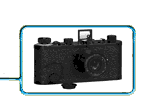 These are sad, yet magnetic works, with a sharp sense of the transitory and pretentious," said critic John Ruch about my current work in a recent show. "Cracked sculptures, abandoned drive-ins, staircases that break off in mid air - they're images of human effort held in check by time's hand."
These are sad, yet magnetic works, with a sharp sense of the transitory and pretentious," said critic John Ruch about my current work in a recent show. "Cracked sculptures, abandoned drive-ins, staircases that break off in mid air - they're images of human effort held in check by time's hand."It thrilled me when I realized that John Ruch grasped part of the emotion and motivation that moved me to photograph elegant ruins.
I didn't start out to photograph structures in decline. In my early days with a camera I photographed buildings that I found exceptional because of the beauty of their design, the skill exhibited in their structure of decoration or their perfect blending of function of detail. I never bothered to analyze what made a building appealing - certain structures just seemed to speak to me!
As the years marched by, I found that more and more of the buildings I admired were showing signs of neglect or abandonment. Many were, sadly, too far gone to photograph. As more years passed, I began to find wonderful old structures that were long-deserted, but seemed transformed by vines, saplings and crumbling edges. These changes raised them to a different plane. There was and air of mystery surrounding them. They seemed to represent a majestic contradiction - grandiose yet abandoned. I felt it a challenge to photograph them to reveal their past splendor.
In these ruins, time has been compressed. Centuries have not passed, wars have not been fought, empires have not fallen. Their demise has been accelerated simply because of rapidly-changing economics or technology. In all areas of our lives we seem to have a fetich for newness and novelty. My age and experience makes me question the merits of newness for its own sake. I like to explore the effects of a disposable society on people's lives. Today's sometimes shoddy workmanship is caused by the need to build quickly. And , of course, who can afford to pay for adornment by skilled artisans when a building is expected to last only a few decades.
In my own hometown, a beautiful Art Deco hotel was scheduled for demolition. Although it was beautiful, the owner wanted to get it out of the way and off the books. When the wrecking began, everyone was stunned that the old building simply refused to fall. It had been designed to stand solidly for centuries. Weeks later, it was finally razed. Its site now occupied by a parking lot. Ironically, just a few months later a motel chain began building a "cookie-cutter" motel two blocks away.
When I can find them, I still photograph buildings that have been lovingly cared for or restored. The old pension office building in Washington, DC and Chicago's former public library are stunning examples.
The Technical Stuff
Because most of these subjects were discovered while on my way to other destinations, I used whatever equipment I had with me-Nikons, a Mamiya RB67 and occasionally a 4x5. In all the cameras I used Kodak's Plus-X or High-Speed Infrared, or on occasion Konica INfrared. All the film was processed in Kodak D-76.
For the past year, I have experimented with litho film developers (Arista A & B Liquid from Freestyle) for processing my enlarging paper. I used highly diluted developers, normally intended for processing high contrast films, followed by standard stop, fix and wash. I found bits of information on this process, but had little success until learning details from Dr. Tim Rudman's book, The Photographer's Master Printing Course.
The prints are one-of-a-kind and impossible to exactly duplicate, even with tight controls. They can be wonderfully soft and subtle or rich and gutsy. All of the time involved in their printing seems worthwhile to me when I see the results. Sometimes negatives I judged impossible to print work beautifully with lith printing. Conversely, other negatives simply will not produce acceptable results with the process.
Print exposure times with this process are extremely long times - usually two to six minutes. Development takes between five to twenty minutes. Print development must be done by inspection. One of the most difficult aspects of the process is learning to judge the exact moment to pull the print from the developer with only safelight to illuminate the image. Images emerge from the developer with wonderful shades of peach, pink, red and purple. Selenium toning must these startling tones and split-toning sometimes creates arresting duotones.
Paper choices are limited - Sterling produces a paper especially for this process - Sterling Premium Lith Paper. It is a semi-gloss, medium-tone, double weight, fiber base paper. You must use a red safelight with the Sterling paper. Luminos' Charcoal R can also be used. It is a warm tone, double weight, fiber-based paper with a water-color paper surface texture. It can be used with yellow safelights. I understand Cachet has a suitable lith paper, but I haven't tried it yet.
- About the Artist
My career in photography began with industrial work. I was the in-house photographer for a steel company. Ten years ago, I launched my own industrial photography business, specializing in on-site photography for heavy industry and construction contractors. Currently, I focus almost exclusively on fine art venues, exhibiting throughout Ohio and adjoining states. I sell through galleries in Mansfield, Cleveland and Columbus.
A show of my portraits - a collaborative project involving written statements from each of the portrait subjects - is scheduled for this summer at the Mansfield Art Center.




